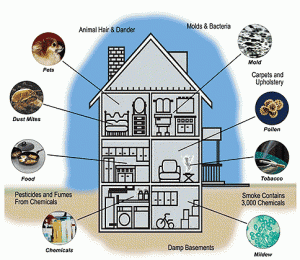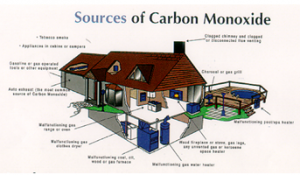The Marion County Public Health Department (MCPHD)’s Indoor Air Quality Program began in the late 1980s. It’s goal is to improve the health of Marion County citizens by reducing exposure to indoor air contaminants. The primary function of this program is to provide advice and expertise with indoor air concerns in homes, schools, offices and public facilities.
To request a FREE radon test, call 317-221-2266 or CLICK HERE.
Regulations
Marion County Health Code
Chapter 10: Residential Property and Housing
Chapter 19: Nonresidential (Commercial) Premises
Chapter 20: Hazardous Materials
Indoor Air Quality Contaminants
RADON
Radon is the leading cause of lung cancer among non-smokers and the second-leading cause of lung cancer among all cases. Radon gas comes from natural (radioactive) breakdown of uranium in soil and can seep into your house from the crawl space of through cracks in your basement or slab foundation. Testing is the only way to know if you and your family are at risk from radon. If your home has elevated levels of radon, you should consider installing a radon reduction system. A good system can be highly effective-some radon reduction systems can reduce radon levels in your home by up to 99 percent. The State of Indiana requires that radon testing businesses and reduction system installers be certified. For a list of state-certified radon professionals, please click on the below link.
Links:
EPA’s “A Citizen’s Guide to Radon”
ASBESTOS
Asbestos is the name given to a group of naturally occurring minerals that are resistant to heat and corrosion. Asbestos has been used in numerous building products, including insulation for pipes, floor tiles, and building materials. During the removal of asbestos materials due to renovation, repairs, or demolition, people can be exposed to the tiny asbestos fibers. Breathing asbestos fibers can cause a buildup of scar-like tissue in the lungs called asbestosis and result in loss of lung function that often progresses to disability and death. Asbestos also causes lung cancer and other diseases, including mesothelioma. MCPHD recommends that homeowners use a locally certified asbestos contractor anytime asbestos-containing materials are disturbed or removed. To know if your home contains asbestos, MCPHD can test building materials for the presence of asbestos. If asbestos is present, MCPHD can offer guidance to reduce the risk of exposure.
Links:
OSHA Asbestos Regulations: 29 CFR 1910.1001
OSHA Asbestos Self Inspection Checklist
City of Indianapolis Asbestos Page- Asbestos contractors, laws and guidance
City of Indianapolis Department of Business Services Permits
MOLD
Molds are part of the natural environment and can be found everywhere, indoors and outdoors. Mold is not usually a problem unless it begins growing indoors. Potential health effects and symptoms associated with mold exposures include allergic reactions, asthma and other respiratory complaints. The best way to control mold growth is to control moisture. Strategies for controlling moisture include:
Indoor Sources
* Fix plumbing leaks, drips or “sweating” pipes.
*Limit sources of indoor humidity/dehumidify indoor air.
*Improve air movement in poorly ventilated areas.
*Increase fresh air ventilation when outdoor air is not humid.
*Warm cold surfaces where condensation occurs.
Outdoor Sources
*Maintain roof and gutter/downspout system.
*Direct runoff away from foundation by grading, drain tile, landscaping, etc.
*Use air conditioning and keep building closed during high outdoor humidity.
*Prevent leakage around windows, doors, flashing, etc.
*Waterproof foundations.
MCPHD does not sample for mold, but staff can determine if there is a water leak or other source of moisture contributing to the mold growth and offer guidance on how to correct.
Links:
EPA’s “A Brief Guide to Mold, Moisture, and Your Home”
EPA’s Flood Cleanup: Avoiding Indoor Air Quality Problems
CARBON MONOXIDE
Carbon monoxide (CO) is an odorless, colorless gas that can cause sudden illness and death if inhaled. Carbon monoxide is found in combustion fumes, such as those produced by cars and trucks, generators, and gas ranges and heating systems.
Carbon monoxide from these sources can build up in enclosed spaces and poison people breathing the air in these spaces. The most common symptoms of carbon monoxide poisoning are headache, dizziness, weakness, nausea, vomiting, chest pain, and confusion. High levels can cause loss of consciousness and even death. MCPHD recommends that all homes have a working carbon monoxide detector on each level of the residence.
Links:
Center for Disease Control and Prevention’s Carbon Monoxide Page
Environmental Protection Agency’s Carbon Monoxide Page
Carbon Monoxide Safety Tips – National Fire Protection Association
Consumer Product safety Commission – Carbon Monoxide Information Center
ENVIRONMENTAL TOBACCO SMOKE
Environmental tobacco smoker (ETS) refers to exposure to tobacco smoke-not from your smoking, but from being exposed to someone else’s cigarette, cigar, or pipe smoke. ETS can also be described as the material in indoor air that originates from tobacco smoke. Breathing in ETS is known as passive smoking, second-hand smoke, or involuntary smoking.
ETS is known to cause cancer in humans. No level of exposure is safe. Breathing ETS can cause heart disease and lung cancer in adults. According to the Centers for Disease Control and Prevention (CDC) and the Environmental Protection Agency (EPA), ETS is the third leading cause of lung cancer after cigarette smoking and exposure to radon.
ETS is especially harmful to children because their bodies are developing, yet nonsmokers aged three to 19 years of age are among the most exposed groups of nonsmokers in the U.S. ETS increases the risk for:
*Sudden infant death syndrome (SIDS)
*Respiratory illness
*Middle-ear disease
*Worsening of asthma in children
*Low birth weight (a newborn’s birth weight is closely related to its risk of early death and long-term morbidity)
Links:
Indiana Smoke-free Website- IN Alcohol and Tobacco Commission
City of Indianapolis Smoking Ordinance
INDOOR AIR QUALITY IN SCHOOLS
Good indoor air quality in schools contributes to a favorable environment for students, performance of teachers and staff and a sense of comfort, health and well-being. These elements combine to assist a school in its core mission- educating children. School indoor air quality management includes:
Links:
Best Practice Sample Documents:
Indoor Air Quality Coordinator
Creating Health Indoor Air Quality in Schools– EPA Page
Additional Resources
Indiana Joint Asthma Coalition (InJAC)
Welcome to Breatheasyville- Learn about asthma triggers in ISDH’s virtual town
Indoor Swimming Pool Irritants– IDOH Fact Sheet
Questions and complaints can be directed to:
Department of Water Quality & Hazardous Materials Management
3901 Meadows Dr., 2nd floor, Indianapolis, IN 46205
Phone: 317.221.2266




